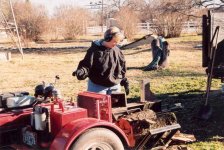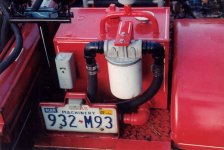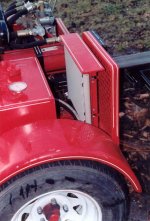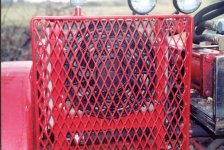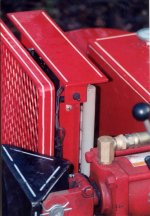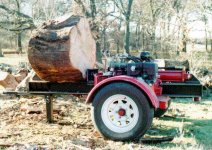You are using an out of date browser. It may not display this or other websites correctly.
You should upgrade or use an alternative browser.
You should upgrade or use an alternative browser.
Log splitter question
- Thread starter cwarrix
- Start date
/ Log splitter question
#21
joetrausch, this was a home made unit so they probably used whatever was available. The 18HP is actually the front end of an old Craftsman lawn tractor. Looks kind of strange sitting atop a log splitter. The head lights still work so you can split wood in the dark if you want /forums/images/graemlins/smile.gif I'll try to get the pump info ASAP so I can figure out what size tank to get/make.
As for the RPM's I have no idea. I'm not even sure what would be an easy way to figure that out. In fact, when I first got this thing I wondered if I should run it full, 1/2, or 3/4 throttle. I just found a speed that I could keep up with and went with it. Hopefully I didn't run it too fast and hurt the pump.
Thanks again for the help!
Chuck
As for the RPM's I have no idea. I'm not even sure what would be an easy way to figure that out. In fact, when I first got this thing I wondered if I should run it full, 1/2, or 3/4 throttle. I just found a speed that I could keep up with and went with it. Hopefully I didn't run it too fast and hurt the pump.
Thanks again for the help!
Chuck
My unit is I think what they call towable or self contained. It has two wheels and a hitch. The reservoir itself is actually the base for the axles. It helps make for a low gravity center. Yes, the vent/filler cap is lower than the pump, cylinder, engine, or control valve. The filler cap is located on the outermost end near one of the tires. It probably would have been better if the manufacturer would have placed it closer to the center of the reservoir near the main "I" beam.
rbargeron
Elite Member
My splitter (home-made) has a 6 hp engine, a commercial 2-stage pump and auto-centering 4-way valve. It has a 1.5 gallon reservoir and works great. The small reservoir works because the return line from the 4-way valve goes straight to the inlet side of the pump, with a tee in the line, and the reservoir mounted above the tee. This way the only flow into and out of the reservoir is the net displacement of the cylinder rod - only about 20% of the total flow. On the return stroke the extra oil goes into the reservoir, on the extend stroke the extra is pulled from the reservoir. I don't know why more splitters are not made this way. There is very little hydraulic line loss because the return piping from the valve to pump can be large and short. The small flow in and out of the reservoir spreads out the heat evenly. There is less plumbing, the unit is neat and compact, and has worked like a charm for many years.
BTW, you can figure the output of your pump by measuring the size of the cylinder and the no-load stroke time. For example, 4" diameter is a common cylinder size. A 24" extend-stroke would use 1.3 gallons. If the stroke took 10 seconds, flow would be 6 x 1.3 or about 8 gpm.
If your pump is 2-stage, it senses back-pressure and directs the oil into its smaller 2nd-stage chamber which puts out more pressure but less volume. (just what you want when the splitting head starts into the log) When splitting pressure drops, flow is directed to the higher-volume stage to speed up the ram. Usually engine rpm will drop a bit during the changeover to the high-pressure chamber, but the governor should restore it right away.
As always, prompt cheerful refund if info is bogus or irrelevant. Take care, Dick B
BTW, you can figure the output of your pump by measuring the size of the cylinder and the no-load stroke time. For example, 4" diameter is a common cylinder size. A 24" extend-stroke would use 1.3 gallons. If the stroke took 10 seconds, flow would be 6 x 1.3 or about 8 gpm.
If your pump is 2-stage, it senses back-pressure and directs the oil into its smaller 2nd-stage chamber which puts out more pressure but less volume. (just what you want when the splitting head starts into the log) When splitting pressure drops, flow is directed to the higher-volume stage to speed up the ram. Usually engine rpm will drop a bit during the changeover to the high-pressure chamber, but the governor should restore it right away.
As always, prompt cheerful refund if info is bogus or irrelevant. Take care, Dick B
GaryBDavis
Gold Member
Here are some pictures of my home made log splitter. The ones that follow will be of a cooler I installed because it would run too hot after a while - especially in the Texas summer heat.
It's a 13hp, 22GPM two stage, 11 Gal tank, 5x30 cylinder, just over 12 seconds of round trip travel time out and back.
It's a 13hp, 22GPM two stage, 11 Gal tank, 5x30 cylinder, just over 12 seconds of round trip travel time out and back.
Attachments
GaryBDavis
Gold Member
The tank has a thermometer mounted in it so I can keep an eye on the temperature. Hydraulic oil runs pretty good at 120 to 130 degrees. The grey box on the left is a thermostat that constrols the cooling fan when the switch is set for automatic.
Attachments
GaryBDavis
Gold Member
GaryBDavis
Gold Member
The cooling fan is a 12VDC fan that is made for hot rods. It draws only a few amps so the altenator keeps up with it. It's controled by the thermostat mounted in the tank. I can adjust the temperature setting for when it comes on and goes off. I also have a three position switch so I can turn the fan on/off manually or leave it in auto mode.

